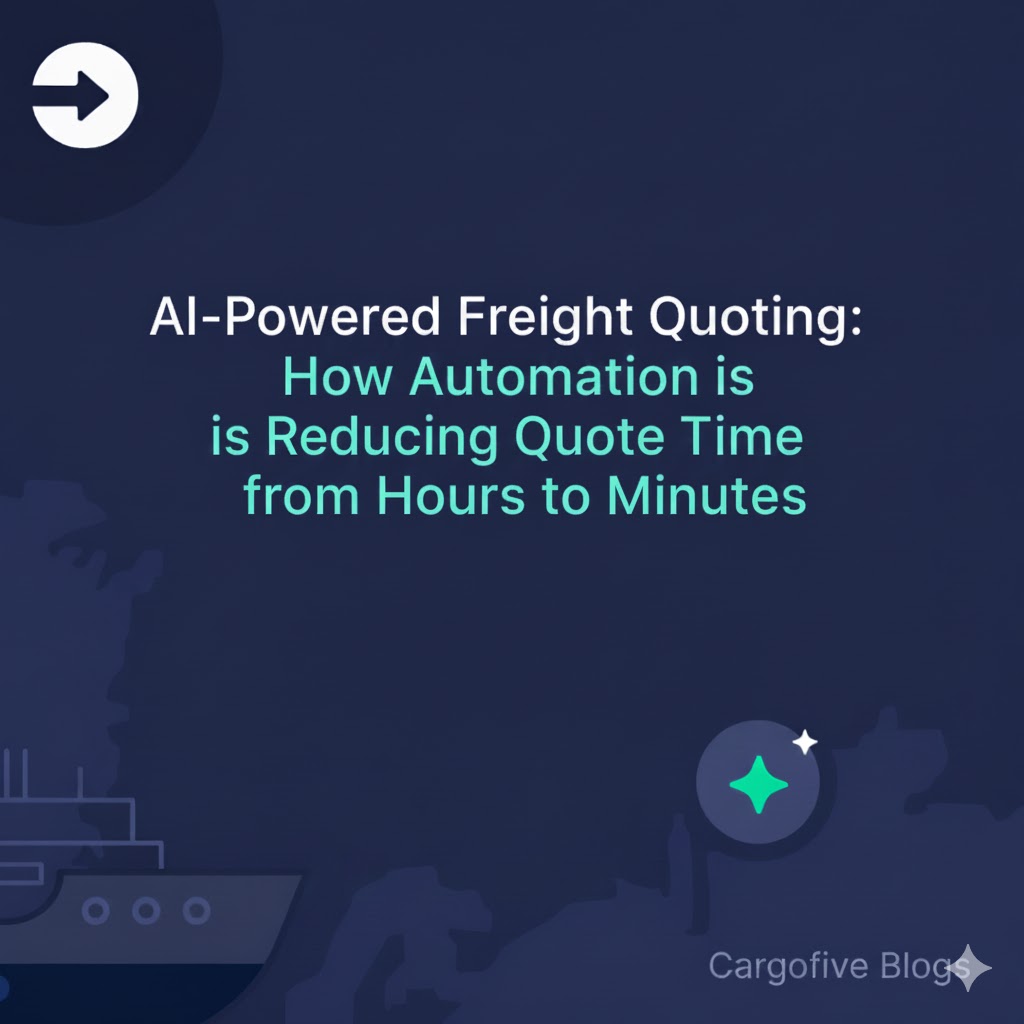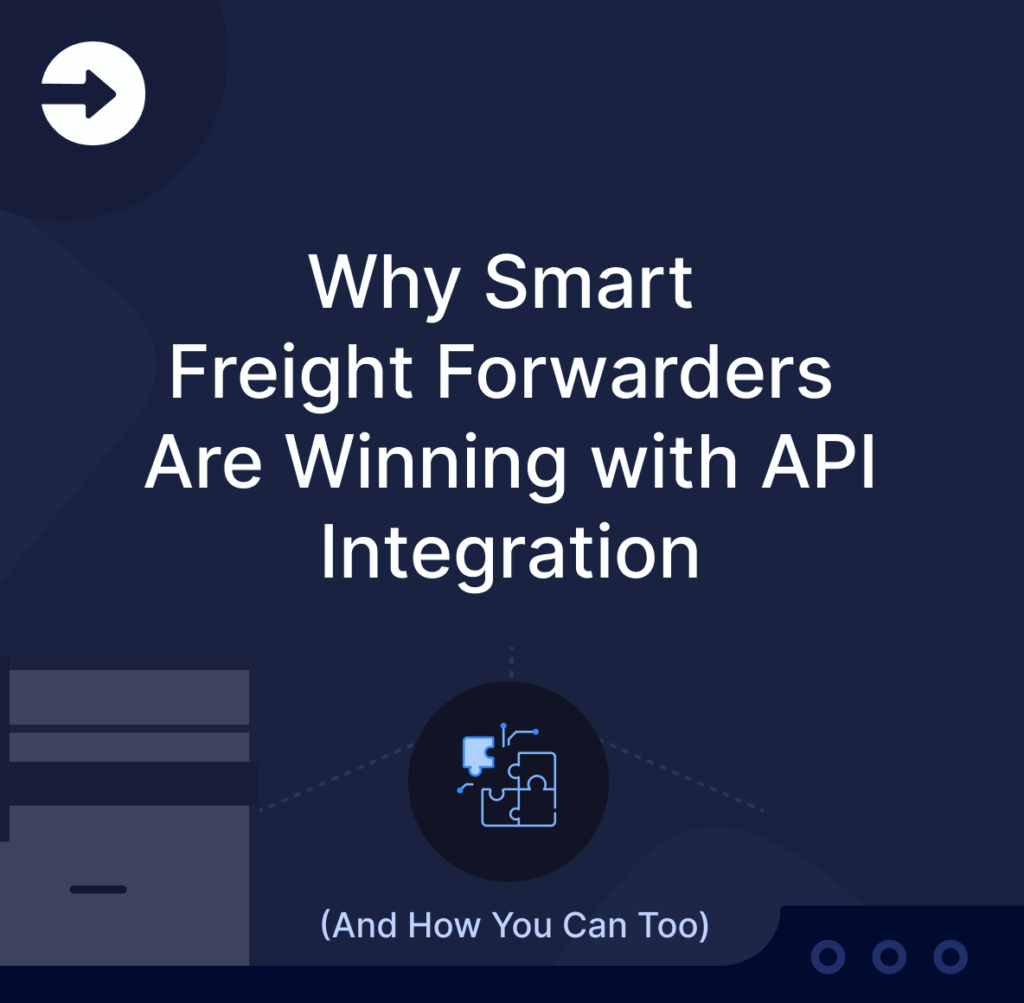Demurrage fees can quickly inflate shipping costs, often caused by delays in loading or unloading cargo. These fees, ranging from $75 to $300 per container per day, result from missed deadlines, customs delays, or port congestion. The best way to avoid them? Use digital tools to stay ahead of potential issues. Here’s how:
- Track Shipments in Real Time: Know where your cargo is and avoid delays with live updates.
- Set Up Automated Alerts: Get notified before free time expires to prevent penalties.
- Centralize Documents: Keep customs forms and contracts in one digital platform to reduce errors.
- Leverage Predictive Analytics: Use AI to forecast potential delays and adjust plans early.
- Integrate Systems: Connect tracking tools with ERP and TMS platforms for streamlined operations.
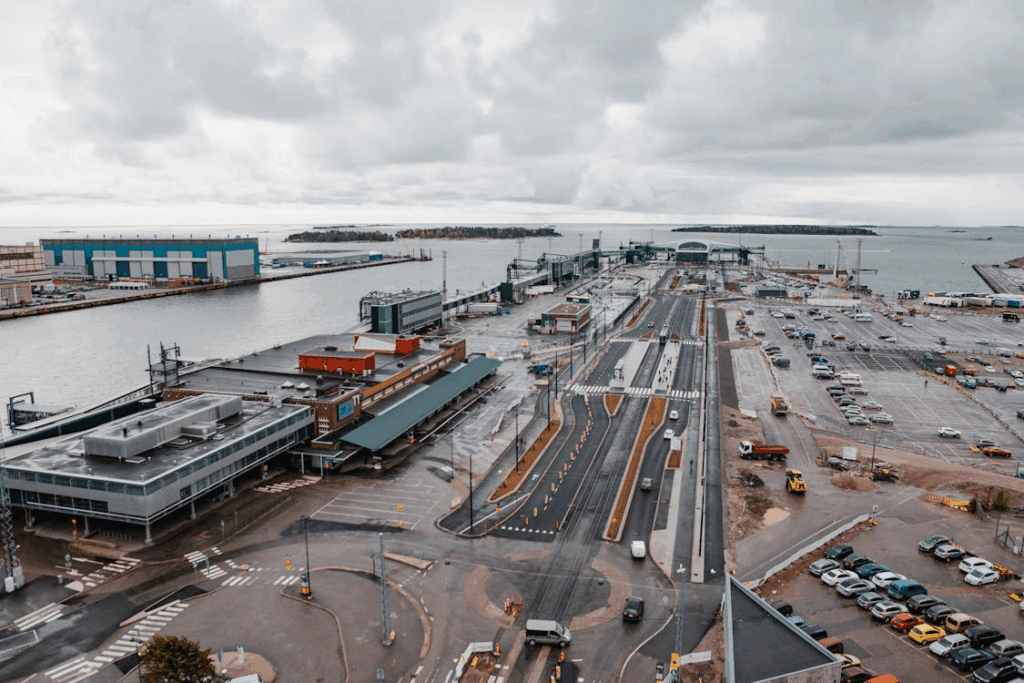
What Are Demurrage Fees and Why Do They Happen
What Demurrage Fees Mean in Freight Logistics
Demurrage fees are daily storage charges applied when containers overstay their allowed free time at terminals, ports, or rail yards. As UPS Supply Chain Solutions puts it, these are “charges applied when a container is left in a terminal past its designated ‘free’ time (also called ‘lay time’)”.
At U.S. ports, the standard free time for containers is typically 4–7 days, while air or rail shipments often have only 48 hours. Once this period expires, demurrage charges kick in, starting on the next full business day.
These charges are usually the responsibility of the consignee and are calculated per container, per day. With over 11 million cargo containers arriving at major U.S. seaports each year, demurrage fees can add up quickly, becoming a significant expense for American businesses.
What makes demurrage particularly frustrating is its blanket application. These charges apply no matter the cause of the delay – whether it’s due to your actions or external factors – ensuring the smooth flow of cargo while penalizing any disruptions. This setup highlights the importance of understanding what triggers these fees.
Main Reasons Demurrage Fees Occur
Demurrage fees can arise for a variety of reasons, including:
- Documentation and administrative issues: Missing customs forms, incomplete paperwork, or delays in receiving required documents can leave containers stuck at ports.
- Payment delays: If payments to port authorities, U.S. Customs and Border Protection (CBP), or carriers are delayed, containers may not be released, leading to additional fees.
- Communication breakdowns: Late notifications or missing shipping documents can disrupt coordination and result in extra charges.
- Operational challenges: Factors like port congestion, labor shortages, or equipment issues can slow down cargo movement.
- External circumstances: Customs inspections, severe weather, natural disasters, or global events – like the 2021 Suez Canal blockage – can extend container dwell times.
- Cargo disputes: Disagreements over shipment terms or mismatches between received cargo and sales orders can delay container clearance while issues are resolved.
How These Fees Affect Your Bottom Line
Demurrage fees can take a serious toll on freight budgets. Daily charges typically range from $75 to $300, and delays beyond the initial five days can cause costs to escalate quickly.
For instance, a 10-day delay at $100 per day would rack up fees between $1,000 and $1,500. For businesses juggling multiple shipments, these expenses can spiral out of control.
In 2022, the Federal Maritime Commission reported that “detention and demurrage charges surpassed $67 million”. For larger companies managing their own freight, these additional costs can increase total shipping expenses by 10–15%.
The impact of these fees goes beyond just the financial hit. As industry experts note, “unexpected or excessive detention and demurrage charges can erode profit margins on shipments, lead to cash flow issues for smaller businesses, force companies to adjust their pricing strategies to account for potential fees, create disputes between shippers, carriers, and freight forwarders over responsibility for charges”.
Operationally, these fees add pressure to speed up the movement of goods, often straining warehouse capacity and forcing rushed decisions. In the end, the costs often trickle down the supply chain, contributing to higher consumer prices. For freight forwarders working with tight margins, even small demurrage fees can turn what should be profitable shipments into financial losses.

Using Digital Tools to Prevent Demurrage Fees
Digital freight management tools play a key role in avoiding demurrage fees. Between April 2020 and March 2023, nine major carriers collected an astonishing $12.9 billion in detention and demurrage charges. According to a 2022 report by McKinsey & Co., digitizing the bill of lading process alone could save $6.5 billion in direct costs, including these fees. Tools like real-time tracking, automated alerts, and system integration can help tackle this issue effectively.
Here’s how these strategies can be put into action:
Track Shipments in Real Time
Real-time tracking is a game-changer for managing shipments and avoiding delays that lead to demurrage fees. These systems provide continuous visibility into cargo location and status by pulling data from multiple sources.
Features like live location updates, shipment status notifications, geofencing alerts, and accurate ETA predictions help teams stay ahead of potential delays. This visibility not only streamlines container management but also improves vessel loading and unloading, reduces port dwell times, and allows rerouting to avoid congested areas.
Set Up Automatic Alerts for Important Events
Automated alerts act as your safety net, flagging critical events like container arrivals or approaching free time deadlines. With demurrage and detention charges having surged by 104% in 2021, setting up alerts at least 24 hours before deadlines can make a big difference. These notifications give you the time to adjust schedules and prevent unnecessary fees.
Connect with Your Existing Freight Management Systems
Integrating digital tracking tools with your current ERP and TMS systems can significantly boost efficiency. Seamless integration reduces logistics costs by 15%, lowers inventory levels by 35%, and improves service quality by 65%.
APIs make this possible by ensuring real-time tracking data flows directly into your systems, eliminating the need for manual updates. For older ERP systems, middleware solutions can bridge the gap, connecting modern tracking platforms with legacy systems.
When integrating, focus on clear objectives – like reducing delivery times or expediting invoice processing – to maximize scalability and prepare for future needs. While integration costs vary, look for solutions that allow smooth updates across tracking and financial systems.
TMS solutions, in particular, often provide a quick return on investment. This streamlined approach ensures container tracking data automatically triggers workflows to control costs and avoid demurrage fees.
Making Documentation and Contracts Easier

Managing documentation effectively is a key step in avoiding costly demurrage fees. Relying on manual paperwork often results in delays, errors, and missed deadlines, all of which can lead to unnecessary charges. Digital freight platforms simplify this process by centralizing documents, automating submissions, and keeping carrier-specific information up to date.
Store All Documents in One Digital Place
Keeping all freight-related documents in a single digital location reduces the risk of delays and mistakes. When key files like bills of lading, customs forms, and carrier contracts are stored centrally, teams can access the information they need instantly.
This approach offers real-time visibility into essential records, such as shipping documents, contract terms, and compliance certificates. It also helps prevent missed deadlines by ensuring that all stakeholders have immediate access to updated information. Automatic updates flag changes in carrier requirements or customs regulations, ensuring that outdated forms or contract terms don’t cause errors. By centralizing documents, businesses can also streamline customs and compliance workflows, making these processes faster and more reliable.
Automate Customs Forms and Submissions
Automation can significantly cut down the time and effort required for customs clearance, reducing the likelihood of delays that lead to demurrage fees. Modern customs software generates forms automatically and uses real-time data sharing to speed up the submission process.
For example, the ACE Secure Data Portal – a free online tool connecting U.S. Customs and Border Protection (CBP), trade partners, and government agencies – simplifies submissions.
AI-powered tools now classify products with high accuracy, offering suggestions based on detailed HS codes and ensuring customs declarations are complete and consistent. These tools validate document types, preferences, and classifications, saving businesses time and minimizing errors.
Electronic Data Interchange (EDI) further supports this process by enabling seamless electronic communication between freight forwarders, customs authorities, and shipping lines. This ensures that forms are accurate and submitted correctly the first time.
Know Each Carrier’s Specific Rules
Beyond managing documents, understanding the specific rules of each carrier is essential for avoiding delays and extra fees. Policies vary widely between shipping lines, including differences in free time allowances, fee structures, and documentation requirements.
Demurrage charges, for instance, can range from $75 to $200 per container per day. Digital platforms simplify this complexity by storing detailed information on each carrier’s rules, such as free time periods and submission deadlines. When a shipment is scheduled, the platform automatically applies the correct rules and sets alerts to keep everything on track.
Failing to account for carrier-specific policies can result in substantial losses. The Ocean Shipping Reform Act (OSRA) of 2022, finalized in 2024, introduced stricter regulations to protect U.S. exporters. It also mandates independent reviews of demurrage and detention charges.
“Demurrage and detention charges help to balance supply and demand. In times of high demand or congestion, these charges deter prolonged storage of cargo and containers.” – Vizion API
Digital tools ensure compliance with these regulations by maintaining accurate records of all carrier interactions. With features like communication tracking, rate confirmation storage, and audit trails, businesses can challenge incorrect fees effectively and avoid disputes over charges.

Using Data Analysis to Stop Demurrage Fees Before They Start
Data analysis is changing the way freight forwarders tackle demurrage fees, moving them from reactive problem-solving to proactive planning. Instead of waiting for delays to happen and then scrambling to address them, modern digital tools now use predictive insights to spot potential issues before they disrupt operations.
This shift is crucial, especially as demurrage costs continue to rise. A 2022 Federal Maritime Commission survey revealed that shippers saw detention and demurrage charges increase by an average of 104% over two years. With such high stakes, predictive analytics has become an essential tool for staying ahead of these fees.
Predict Problems and Delays Before They Happen
AI-driven systems are at the heart of this proactive approach. These tools analyze massive datasets, including weather forecasts, traffic conditions, and port congestion, to predict delays before they impact shipments. By combining real-time data with historical shipping patterns, these systems identify risks early, giving logistics teams the time they need to adjust plans and sidestep costly fees.
One major advantage of these systems is their early warning capabilities. For example, AI can flag potential bottlenecks – such as severe weather or labor shortages – prompting teams to make timely adjustments. When terminals face congestion, logistics teams can reschedule pickups to avoid detention or demurrage charges.
Take Unity SCM’s success story as an example. They helped a petrochemicals manufacturer completely eliminate demurrage fees within five months. Their solution provided dynamic shipment ETAs and detailed container information, including availability, free days, and return schedules. This allowed the manufacturer to optimize pickups and allocate drayage resources more effectively.
Advanced scheduling tools and container tracking systems make this process even smoother. Scheduling tools optimize pickup and drop-off times based on predictive insights, while tracking systems monitor container locations in real time. Together, they create a robust system that prevents delays instead of just reacting to them.
Use Data Dashboards to Watch for Patterns
Data dashboards take it a step further by turning raw data into actionable insights. These visual tools pull information from GPS systems, IoT sensors, and logistics platforms, helping teams spot patterns that would otherwise be missed. For example, dashboards can reveal which carriers consistently incur the highest demurrage fees, which ports are prone to delays, and what common issues lead to surcharges.
Centralized dashboards make it easy to monitor free time usage across all carriers. Teams can set up alerts for containers nearing the end of their free time or when unexpected delays occur, allowing for quick action to prevent extra charges.
A leading retailer’s partnership with C3 Solutions illustrates the power of these tools. By implementing dock scheduling software, the retailer streamlined scheduling, automated notifications, and reduced dock delays. Within six months, they cut demurrage charges by 30%. The improvements didn’t stop there – they also enhanced load management and delivery accuracy, boosting customer satisfaction.
Dashboards also provide comprehensive tracking of container milestones, from pickup to return. They collect data from terminals, trucking providers, and team logs, enabling pre-invoicing based on contracted rates and automatic invoice checks. This ensures smooth operations and accurate billing.
Route optimization becomes more precise when dashboards analyze data like traffic patterns, weather, and delivery schedules in real time. They also track vendor and carrier performance, measuring factors like reliability, cost-effectiveness, and service quality. This helps businesses identify the best partners for future shipments.
The most effective platforms go beyond internal operations by offering transparent, interactive tracking for shipments and order statuses. This not only improves internal efficiency but also enhances the customer experience. Regularly reviewing shipping and receiving schedules helps uncover bottlenecks and ensures maximum use of free time.
Additionally, businesses should invest in systems that monitor critical data points like timelines, processes, and dispute mechanisms to handle detention and demurrage charges effectively. For example, tracking container timelines – including expected arrival, unloading, and customs clearance dates – alongside process data like average wait times for customs clearance and port congestion, is key for staying ahead of potential issues.
How Cargofive Helps Manage Freight Operations
Cargofive offers a customized solution for U.S. freight forwarders, built on proactive data analysis. While modern tools like data analysis and predictive systems are essential for avoiding demurrage fees, the right platform to implement these strategies is equally important.
Cargofive tackles the specific challenges faced by U.S. freight forwarders, such as managing intricate rate structures, tracking shipments, and maintaining operational efficiency – all of which are critical to keeping demurrage costs at bay.
Features Designed for U.S. Freight Forwarders
Cargofive simplifies freight operations, helping businesses avoid demurrage fees. Its real-time shipment tracking provides visibility into shipments at every milestone, enabling users to anticipate delays before they escalate into costly penalties. Additionally, its intelligent contract processing engine digitizes and organizes carrier rates, removing the need to sift through spreadsheets, PDFs, or email chains.
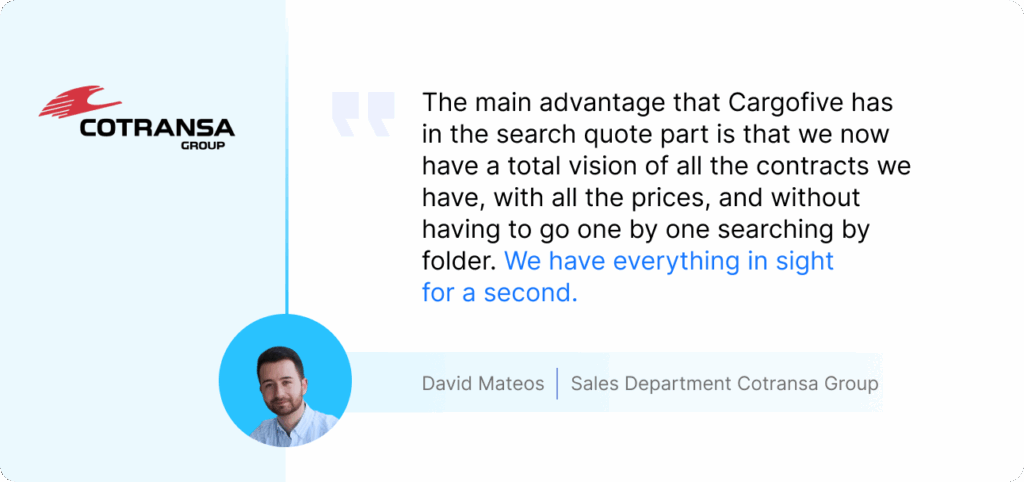
This centralized rate visibility allows freight forwarders to make quicker, better-informed decisions. In a market where conditions change rapidly, automation becomes a game changer. As Elizabeth Piña, a Digital Transformation executive, puts it:
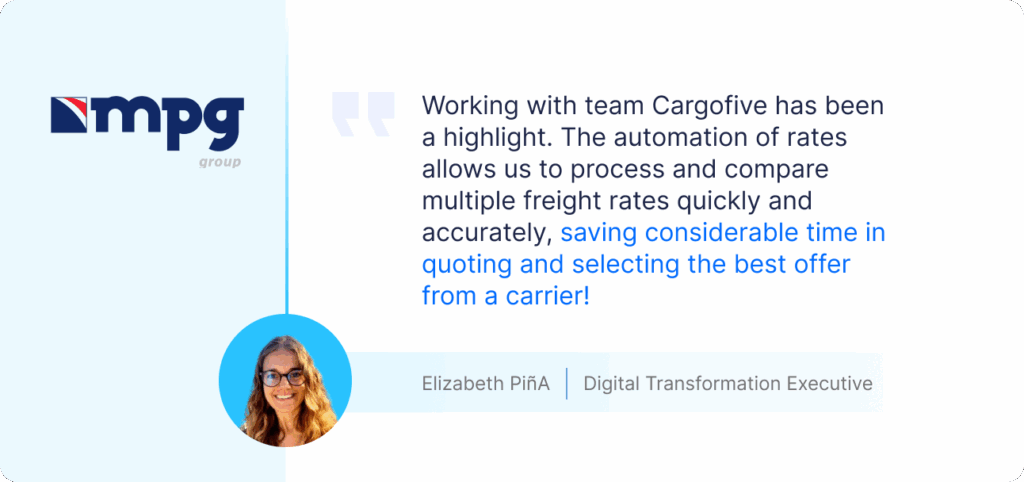
This efficient tracking and rate management sets the stage for even more advanced system integration, which is explored next.
Benefits of Connecting with ERP/TMS Systems
What sets Cargofive apart is its ability to integrate seamlessly with ERP and TMS systems, filling operational gaps that can lead to demurrage fees. Acting as a centralized hub, Cargofive feeds real-time rate data directly into ERP financial systems and TMS workflows.
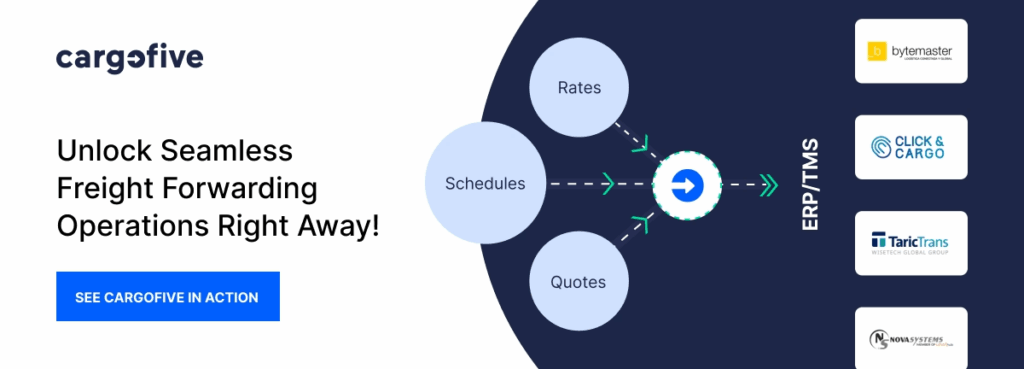
This ensures that when rates change – a frequent occurrence in today’s volatile shipping landscape – both ERP and TMS platforms are automatically updated, keeping pricing accurate across the board.
The benefits of integration are clear. Companies that connect their ERP and TMS systems can cut logistics costs by 15%. Cargofive goes even further, showing a 25% reduction in total operational costs. The platform has also demonstrated the ability to reduce delays by 30% and cut costs by 15%.
| System Integration | Cargofive Integration |
|---|---|
| Rate Updates | Automatic real-time synchronization |
| Data Accuracy | Consistently updated data across platforms |
| Response Time | Instant access to all contracted rates |
| Operational Efficiency | Streamlined workflows for unified operations |
Automated order creation further enhances efficiency by reducing manual input, a common source of delays.
These integrations not only streamline processes but also pave the way for centralized operations, which are discussed next.
Save Money Through Centralized Operations
Cargofive’s centralized operations model tackles the root causes of demurrage fees by eliminating inefficiencies and improving decision-making speed.
By automating over 90% of manual tasks, the platform frees up resources and delivers a 25% reduction in operational costs, much of which stems from avoiding penalties like demurrage fees. Additionally, its API provides instant access to current pricing.
This centralized approach is particularly beneficial for companies juggling multiple shipping relationships. As Javier Alvarez Suarez, Director Commercial, shares:
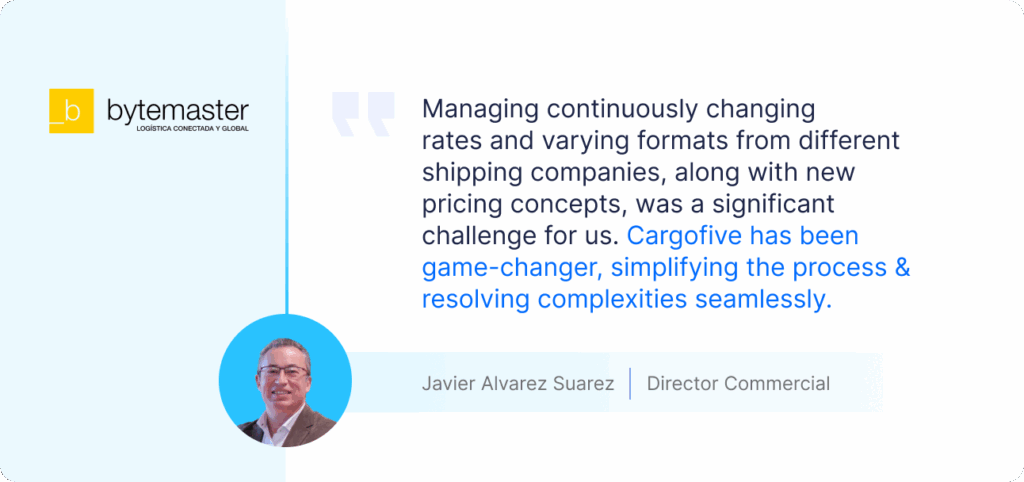
Conclusion: Go Digital to Avoid Demurrage Fees
Switching to digital tools transforms freight management from a reactive process into a proactive one, helping to cut down on demurrage fees. By automating repetitive tasks, offering actionable insights, and supporting smarter decision-making, these tools improve cost management and strengthen supply chain operations.
With real-time tracking and advanced data analytics, freight forwarders gain the ability to manage costs more effectively and avoid unnecessary delays.
This guide highlighted key digital solutions like real-time tracking, automated alerts, integrated systems, and data analytics – all designed to prevent delays and keep operations running smoothly. These tools give logistics teams the ability to act before issues arise, avoiding disruptions that could lead to additional fees.
The advantages of digital tools go beyond what manual systems can provide. For instance, an automated alert notifying a team when a shipment is nearing its free time limit at a U.S. port allows them to take immediate action – whether that’s expediting customs clearance or arranging a pickup.
This kind of proactive response can eliminate demurrage charges entirely. Tools like Cargofive are tailored to meet U.S. logistics requirements (e.g., USD currency, MM/DD/YYYY date formats), ensuring seamless integration into existing workflows.
Adopting digital solutions is more than just a technological upgrade – it’s a strategic move to strengthen operational resilience. During challenging times, such as port congestion or labor shortages, having digital tools in place ensures visibility and control over shipments.
By leveraging real-time tracking, automated notifications, and integrated analytics, logistics professionals can avoid unnecessary costs, remain competitive, and build more adaptable supply chains. Start implementing these digital strategies today to secure both cost savings and a stronger, more reliable operation.

FAQs
How can digital tools help prevent delays that result in demurrage fees?
Digital tools have become essential for cutting down delays that can lead to demurrage fees. With real-time updates and predictive insights, these tools keep tabs on container statuses, port conditions, and vessel schedules. This allows businesses to react quickly to changes, like early or late arrivals, ensuring containers are picked up on time and avoiding extra storage costs.
On top of that, advanced platforms leverage data analytics and predictive algorithms to spot potential delays before they occur. By examining historical data alongside current conditions, companies can plan more effectively, streamline their operations, and improve coordination across all involved parties. These capabilities not only help sidestep demurrage fees but also boost the overall efficiency of the supply chain.
What features should a digital freight management tool have to help avoid demurrage fees?
To stay on top of demurrage fees, consider using a digital freight management tool that offers real-time container tracking and automated alerts. These alerts can notify you when free time is running out, helping you take action before charges kick in.
Look for tools that also include integrated rate management and detailed cost reporting, which make it easier to track expenses and spot opportunities to cut costs. With these features, you can plan ahead and tackle delays quickly, keeping your shipping expenses in check.
How can digital tools improve freight management and help reduce costs when integrated with ERP and TMS systems?
Integrating digital tools with your current ERP and TMS systems can completely reshape how freight management works. These tools simplify operations, take over repetitive tasks, and give you real-time insights into your supply chain. Whether it’s route planning, shipment tracking, or handling documentation, these systems help cut down on delays and avoid costly mistakes.
When done right, this integration can lead to noticeable improvements – like cutting logistics costs, lowering inventory levels, and boosting overall efficiency. By automating workflows and tapping into more accurate data, businesses can raise service standards and make smarter decisions that save both time and money.
AUTHOR

